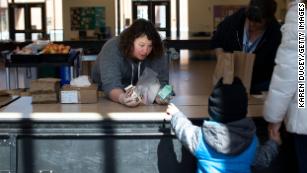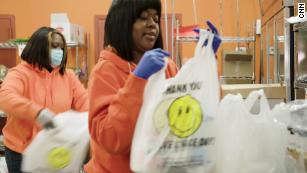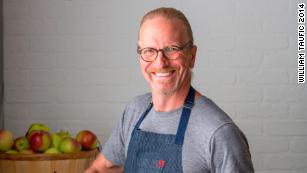Opinion by Akash Goel, Michel Nischan, Bill Frist and Tom Colicchio
Updated 9:17 PM ET, Sun August 2, 2020
(CNN)This global pandemic has given a new meaning to the idea of American exceptionalism. The United States is faring far worse than other countries and shoulders a disproportionate share of global disease burden -- with 4% of the global population, yet, at the time of writing, nearly a quarter of global Covid-19 fatalities.
While much of the rationale has focused on our government's flat-footed response and poor public health infrastructure, this ignores a significant and underrecognized risk factor -- the exceedingly poor baseline health of our country's population.
Among the most significant risk factors for hospitalization and death in Covid-19 are the presence of diet-related chronic diseases such as hypertension, heart disease and obesity. America's starting point? Nearly three out of four American adults are overweight or obese.
And half of US adults have diabetes or pre-diabetes. A 2018 study found that only 12% of Americans are metabolically healthy, which is defined as having optimal levels of blood markers and pressures as well as waist circumference. Diet-related diseases are no longer the things you have to worry about down the road. In a pandemic environment, they could hasten death next week.
Poor metabolic health stems, in part, from poor-quality diets and poor nutrition. Just as baseline chronic disease portends a worse outcome for individuals with Covid-19, our food system is our country's pre-existing condition that leaves us all at greater risk. As doctors and chefs, we feel that now, more than ever, it is critical to address nutrition insecurity in America head on.
While food insecurity is about providing more food, nutrition insecurity is about providing the right food, so we and our children can build the metabolic heath we need to better survive this and future pandemics.
Most of our legacy food policies were born of national security concerns in the 1940s. They were conceptualized during a time of absolute caloric deprivation, when as many as 40% of military recruits were ineligible for service because of malnutrition and being underweight. Soon initiatives such as the National School Lunch Program, the modern food stamp program and other nutrition assistance programs followed.
In the private sector, subsidies enabled mass production and stockpiling of food in preparation for food scarcity during the next global conflict. The postwar industrialization of food led to a domestic food market rife with highly processed, carbohydrate-laden, shelf-stable and convenient foods.
Consumption of these cheap products increased, while consumption of fresh fruits and vegetables decreased. The American diet flipped from largely whole foods to highly processed foods requiring little time and cooking. The diet-related disease debacle we face today is one unintended outcome.

We may not have a cure for the coronavirus, but we do for hunger
Programs born of good intent for reasons of national security and convenience no longer fit the bill. Instead of keeping our children and most vulnerable healthy and productive, we are now sicker than we were post-Depression. A 2018 report filed by Mission: Readiness, a council of retired admirals and generals who advocate for policies that help kids stay healthy, in school and out of trouble, stated that, "In the United States, 71 percent of young people between the ages of 17 and 24 do not qualify for military service," noting exceptionally high rates of obesity starting as early as age 2.
The numbers have flipped, and so have the health conditions. Fewer Americans are physically ready for work and war than in 1945, yet, instead of being underweight and malnourished, they are overweight and malnourished.
Now during this pandemic, our industrialized food system, optimized for efficiency over resilience, seems to be failing. One only has to witness farmers dumping milk and fresh produce and see the Depression-era-style lines wrapped around food banks to realize the depths of our food crisis. Now is the time to both address nutrition insecurity and support regional and specialty farmers.
While there are significant financial and distribution challenges that our food system is facing during the pandemic, there are still important things we can do right away to help improve nutrition security.

Food banks overwhelmed by demand 03:02
We see an opportunity to leverage the greatest impact in public health through changes to the federal Supplemental Nutrition Assistance Program (SNAP), which serves about 40 million Americans.
We can promote better health by valuing quality of calorie over quantity. Ten percent of SNAP dollars go toward the purchase of sugary sweetened beverages, which amounts to a roughly $7 billion subsidy toward sugar. This can easily be fixed by doubling down on the USDA's fresh produce incentive, which combines federal, state and philanthropic dollars to support the purchase of fruits and vegetables.
Modeling studies suggest that combined incentive and disincentive programs are cost neutral, yet lead to significant gains in health outcomes and cost savings equaling roughly $10 billion over five years. SNAP has had early success with incentive-based pilot programs, which if expanded offer significant gains for public health.
Our response to food insecurity during the pandemic has focused largely on supporting food banks, but this is not working. In April, for example, 10,000 cars lined up in San Antonio in just one day, with thousands having waited overnight for their place in line.
In New York, people are waiting up to six hours in line at distribution sites. Executive leadership at the top emergency feeding organizations have called on Washington to expand SNAP, rather than drive people to already overtaxed and underresourced facilities.
Expanding SNAP offers the added benefit of stimulating local and regional economies. The USDA economic impact model suggests that every dollar spent on SNAP is an economic multiplier, yielding up to $1.50 in economic activity. As a large share of SNAP recipients live in rural regions, the subsidy often supports small business such as farmers, local food retailers and grocers. A 2016 study showed that this multiplier effect is even greater when SNAP dollars are redeemed at farmer's markets.
With food insecurity rampant in the midst of an economic down cycle, bolstering investments in SNAP benefits are a win-win. It would have been a boon to the San Antonio retail grocery economy if those 10,000 cars instead went to any of the many grocery stores and supermarkets with SNAP benefits to buy the food of their choice.
Get our free weekly newsletter
Sign up for CNN Opinion's new newsletter.
Join us on Twitter and Facebook
Now is the opportunity to connect the dots between our food system and health. We have too long operated in silos to the detriment of both food and public health. Roughly 65% of adults receiving SNAP are on Medicaid, according to a report from the Bipartisan Policy Center.
We have the ability to track how food and nutrition incentives may support better health outcomes and drive cost savings, while supporting retail grocers and farmers. Once this link is drawn, we can rebuild a better system focused on health promotion and prevention rather than treating the long-term and unsustainable consequences of chronic disease.
The American food system is not broken -- it is functioning as designed, a system optimized for efficiency, not one optimized for resilience and nutrition. But our food system is killing us, and that happened long before Covid-19. It is bound to continue unless we take steps now to leverage food as medicine.
------------------------------------------------------------------------------------------------------------------------
Akash Goel is an assistant professor of medicine at Weill Cornell/NewYork Presbyterian Hospital and term member of the Council on Foreign Relation. Michel Nischan is a James Beard Foundation Award winning chef and sustainable food advocate. He is founder, president and CEO of Wholesome Wave and co-founder of the Chefs Action Network.
Bill Frist is a heart transplant surgeon, former US Senate majority leader and a senior fellow at the Bipartisan Policy Center. Tom Colicchio is a James Beard Foundation Award winning chef and owner of Crafted Hospitality. He is the head judge and executive producer on Bravo's "Top Chef." The opinions expressed in this commentary are those of the authors; view more opinion on CNN.

Akash Goel

Michel Nischan

Sen. Bill Frist

Tom Colicchio
No comments:
Post a Comment